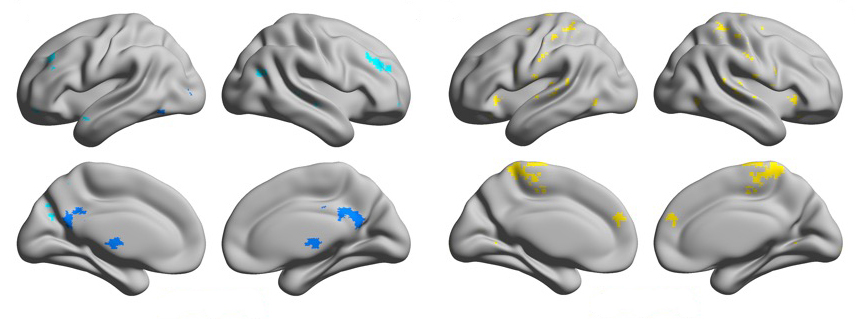
THIS ARTICLE IS MORE THAN FIVE YEARS OLD
This article is more than five years old. Autism research — and science in general — is constantly evolving, so older articles may contain information or theories that have been reevaluated since their original publication date.
The brains of men with autism have a mosaic of features from both genders, a new study suggests1.
The findings may help reconcile conflicting theories about the sex bias in the autism brain. One theory holds that people with autism have extreme versions of the typical male brain. Another, the ‘gender incoherence theory,’ proposes that men with autism show female traits and vice versa.
The new study hints that parts of both theories are true, depending on the part of the brain under scrutiny.
“There’s a representation of both models, and [this] varies depending on the functional network,” says lead researcher Adriana Di Martino, associate professor of child and adolescent psychiatry at New York University’s Langone Medical Center.
The findings indicate that men with autism show ‘female features’ in a sensory-motor brain network, but exaggerated male traits in other networks.
“It’s a nice example [that] it’s not more masculine or more male — their brain type — but it’s just a unique combination which is correlated or associated with autism,” says Daphna Joel, professor of psychology and neuroscience at Tel Aviv University in Israel, who was not involved in the study.
Altered ties:
Di Martino and her colleagues looked at brain scans from 357 typical boys and men and 471 typical girls and women, aged 8 to 78 years, taken while the individuals were at rest. (These scans came from the 1000 Functional Connectomes Project.) They also analyzed scans from 360 boys and men with autism and 403 typical ones, aged 6 to 58 years, from the Autism Brain Imaging Data Exchange (ABIDE).
They examined the extent to which pairs of brain regions become active in tandem. Regions that are simultaneously active have a high degree of connectivity. The researchers then looked for brain areas in which connectivity differs between typical men and women and between men with and without autism.
Men with autism show an extreme male shift in the default mode network, which governs daydreaming and rumination, the researchers found. In this network, the men show decreased connectivity compared with typical men, who, in turn, have less connectivity than typical women. The results appeared 6 March in Molecular Autism.
This finding jibes with that of a 2016 study that showed extreme male connectivity patterns in the default mode network in 408 boys and men with autism, using data from ABIDE2.
The researchers also found an overly male profile in brain networks involved in goal-directed behavior or attention. (In these areas, the men with autism have unusually high connectivity.)
Mosaic minds:
By contrast, in a network of sensory and motor brain regions, boys and men with autism show a shift toward femaleness. A 2016 study showed a similar trend3.
Many of the functions served by these networks are impaired in people with autism, Di Martino says, so the fluctuations in connectivity patterns may underlie some features of the condition.
These analyses are robust, says Lucina Uddin, associate professor of psychology at the University of Miami in Florida, who was not involved in the work. But interpreting the data in the context of sweeping gender theories may not be fruitful, she says.
The literature supporting sex differences in the typical brain is shaky, “so then it’s another stretch to say in autism [the brain is] either going more towards the male end or more towards the female end,” Uddin says.
The brains of typical individuals are also mosaics of prototypical male and female features, so this patchwork may simply look different in autism, Joel says.
By focusing exclusively on men and boys, the new study sheds light on only half the equation. Di Martino plans to look for gender-related connectivity patterns in girls and women with autism when enough data are available.
By joining the discussion, you agree to our privacy policy.